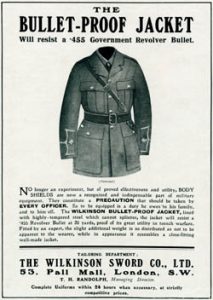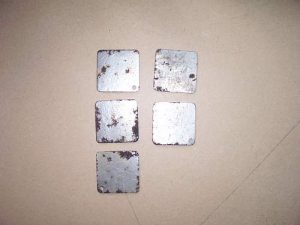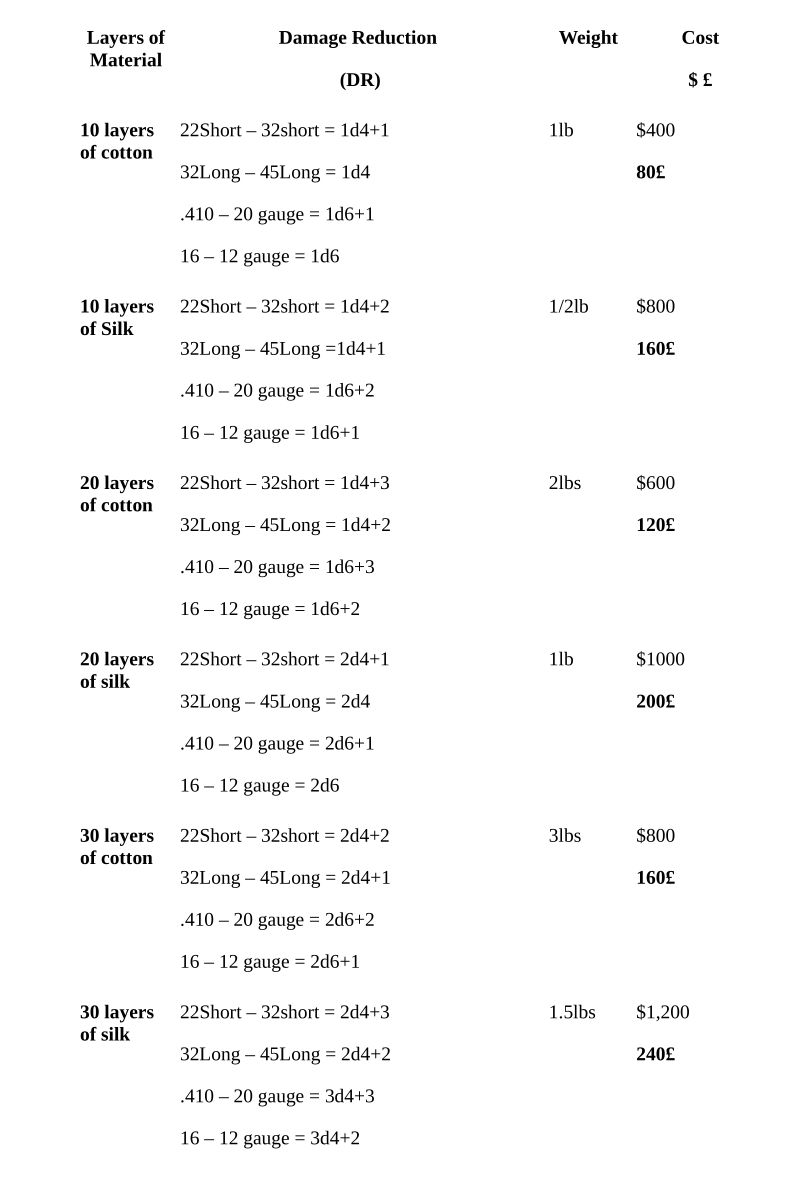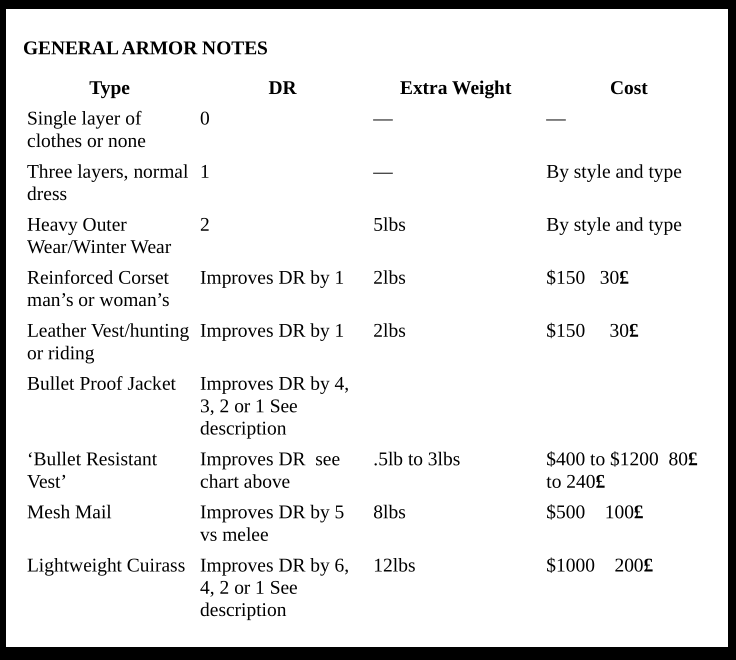Armor and Armor Class
Body armor, the staple of battlefields for millennium, has largely been relegated to museums and ceremonial functions. Firearm and gunpowder improvements in the last fifty years have rendered most armor obsolete. Being fleet of foot is essential in modern combat. Dexterity is the key to survival. AC bonuses based on Class and Level, have been increased to make modern battle more survivable.
A character’s Armor Class (AC) represents how hard it is for opponents to land a solid, damaging blow on the character. The average, unarmored individual in light clothing (or none at all) has an AC of 10 if he or she makes no attempt to evade.
Wearing Traditional Armor or Body Armor (see below) does not make you harder to hit. It does NOT improve Armor Class, in fact it can negate some or all of the extra Defensive Adjustment a character has. However, it DOES Absorb SOME Damage from things that do hit you.
Dexterity Modifier
If a character’s Dexterity is high, he or she is particularly adept at dodging blows or gunfire. If a character’s Dexterity is low, he or she is particularly inept at it. Characters apply their Dexterity modifier and their Defensive Adjustment, to AC.
Sometimes a character can’t use his or her Dexterity bonus. If a character can’t react to a blow, that character can’t use his or her Dexterity bonus to AC.
NOTE: Characters DO NOT DODGE BULLETS! The Dodge reflects dodging the shooter’s aim or shot, NOT the actual bullet in flight.
Unarmored Defense Bonus
A character’s class and level grant the character an innate bonus to AC. This bonus applies in all situations, even when the character is flat-footed or when the character would lose his or her Dexterity bonus for some other reason. NOTE: This Bonus ONLY applies when a character is NOT wearing armor!*
A character has a Defense Bonus based on his character class and level. The Defense Bonus applies ONLY to Armor Class. The Defense Bonus DOES stack with all other bonuses to Armor Class, including the character’s, Dexterity Defensive Adjustment, magic and so forth. EXCEPT actual Armor!*
The Defense Bonus DOES improve a character’s Armor Class against touch attacks.
A character’s Defense Bonus is derived from his character level and class, as shown on the Defense Bonus Table.
(*Some exceptions apply. See armor descriptions for details.)
Defense Bonus Table

Armor
If a character wears physical armor, the Defense Bonus is generally negated. Armor does however absorb or negate some, or all, of the damage that the character may take from a hit. This is Damage Resistance
Damage Resistance (DR)
Damage Resistance is subtracted after the appropriate Damage Dice are rolled and any Strength modifiers are added. But BEFORE bonuses for Damage Type (Impaling, Cutting, etc) or Natural 20 or Critical Hit bonuses are applied! Damage Resistance Stacks!
Magical damage may or may not be effected by Damage Resistance, depending on the nature of the spell.
An individual who is naked or wearing little more then a shirt or singlet, has 0 Damage Resistance.
Multiple layers of clothing, undergarment, shirt, vest, coat, over coat (for men) or the multi layer garments of women in the age, grant 1 point of Damage Resistance.
Wearing heavy outer wear, for cold weather, improves DR by 1 making someone dressed for winter weather have a total DR of 2.
There are several armor alternatives available that will improve Damage Resistance. Some armor is better against some types of attacks then other types.
For men, and women, there is the Leather Hunting Vest. Worn under a coat in place of a normal waistcoat it is made of heavy but flexible layers of leather often lined with cotton or silk. It usually has a variety of pockets and attachments for shells, game bags etc though dressier versions can be had. It improves the wearer’s DR by 1.
The Leather Hunting Vest weighs 2lbs and costs $100 20£
NOTE: Wearing the Hunting Vest over a Cuirass (see listings) WILL NOT improve the base DR of that armor. It can improve the DR of Mesh Mail or Bullet Resistant Vests with no Dexterity Penalty.
For women there are Reinforced Corsets. The corset, a traditional and expected part of a lady’s attire, can have additional reinforcement added to it over vital areas. A well fitted corset, even reinforced, has no major effect on movement (modern opinions otherwise) though it takes some practice to wear one comfortably and learn to move gracefully and breath properly! The Reinforced Corset will improve the wearer’s DR by 1. Reinforced Corsets add 1lb to the weight of a normal corset and costs $150 30£
NOTE: It MAY be worn with Leather Hunting Vests OR Mesh Mail OR Bullet Proof Jacket with no penalty. IF worn with a Leather Hunting Vest AND Mesh Mail it reduces the character’s DX by 2.
Although it is very much out of style, Men’s Corsets do exist. (They were common in the 1840’s and 50’s but are long since outdated. A man wearing one WILL be noted by anyone with fashion sense. (Middle and Upper Class people will notice it immediately, lower class might notice.
Wearing a Hunting Vest AND a Reinforced Corset WILL provide cumulative DR.
Bullet ‘Proof’ Jacket

Wilkinson Bullet Proof Jacket
Despite the claim, these ARE NOT actually bullet proof! They DO however, reduce the damage done by bullets.
These are variations of similar jackets that were first used in the American Civil War. They are essentially a tailored Uniform Jacket (of the appropriate service branch) with interior pockets that hold steel plates. The “Soldiers’ Bullet Proof Vest” was manufactured by the G. & D. Cook & Company of New Haven, Connecticut. It consisted of two pieces of steel inserted into the pockets of a regular black military vest. Versions for infantry weighed 3 ½ pounds while a version for cavalry and artillery weighed 7 pounds. They sold for $5–7 in the 1860’s. (The Wilkinson Jacket described here was actually developed for WWI and is a bit out of time period.)
Wilkinson Steel’s version uses multiple small plates sewn into a canvas, quilted lining that can be ‘buttoned’ into the inside of the tailored uniform jacket. (Or custom civilian jacket.) It is not complete protection, bullets (or blades) can slip between the plates (they are about 2″x 2″ each) making the jacket DR 4 vs swords, knives and other Melee weapons. And it ONLY covers the Torso. Versus PISTOL bullets of UP TO .32 caliber the jacket has a DR of 3 vs the damage done before Impaling bonus. Versus PISTOL bullets larger then .32 caliber, and all shot gun blasts, the jacket subtracts 2 point from the damage done before Impaling bonus. Versus Rifle and Carbine bullets the jacket has a DR of 1 before Impaling bonus.
Since the actual tailoring needed to make these is minimal, the jackets sell for $50 (10£) The jacket weighs 6lbs and covers front and back. Note: A Reinforced Corset or Bullet Resistant Vest MAY combined with these jackets with no penalty to the character’s Dexterity. Combing this jacket with a Leather Hunting Vest or a Cuirass will reduce the wearer’s Dexterity by 4. It CANNOT be combined with Light Mesh.

Wilkinson Inserts
Bullet Resistant Vests
(Note: This is as good as it gets!)
These are the ONLY type of armor that may be worn WITHOUT losing the Unarmored Defensive Bonus. Only ONE layer may be worn and still retain the UDB.
Myeonje baegab is a soft ‘bulletproof’ vest invented in 1867 in the Joseon dynasty of Korea. It was developed following the French Campaign against Korea in1866 and used in battle during the United States expedition to Korea in 1871. It was made of between 13 and 30 folds of cotton fabric and covered the upper torso.
In 1881, Tombstone physician George E. Goodfellow noticed that a faro dealer, Charlie Storms, who was shot twice by Luke Short had one bullet stopped by a silk handkerchief in his breast pocket that prevented that bullet from penetrating. In 1887, he wrote an article titled Impenetrability of Silk to Bullets for the ‘Southern California Practitioner’ documenting the first known instance of bulletproof fabric. He experimented with silk vests resembling medieval gambesons, which used 18 to 30 layers of silk fabric to protect the wearers from penetration.
Fr. Kazimierz Żegleń used Goodfellow’s findings to develop a bulletproof vest made of silk fabric at the end of the 19th century, which could stop the relatively slow rounds from black powder handguns.
These vests absorb SOME damage from bullets and prevent SOME bullets from penetrating flesh. They CANNOT stop all of a bullet’s energy, so there is still damage taken, but there is a reduced chance of a wound (beyond serious bruising) It is NOT 100% protection. When struck by a bullet the vest may (or may not) prevent any real Hit Point Damage. Even if the vest manages to reduce the bullet damage to zero, the wearer will still FEEL the hit. Treating the hit as a Punch that does 1d4 NON LETHAL DAMAGE. This is bruising. And though painful the character will recover the lost Hit Points at a rate of 1 per Minute. The bullet hit will cause Spell Casters to lose concentration and interrupt most actions for anyone hit. It is possible for a character to be rendered unconscious if struck by enough bullets, even if the individual bullets do not manage to penetrate the vest.
They CAN be doubled up but doing so will reduce the character’s Dexterity by 1 AND will eliminate the wearer’;s Unarmored Defense Bonus.
The double layering the vests will increase the DR of the BEST vest by an additional 50%, rounded up. Example: A 10 layer Cotton Vest is worn with a 20 layer Silk Vest. A .32 caliber bullet hits the wearer. Normal reduction for the Silk Vest is 2d4. The Player rolls 6. The extra vest allows that to be increased to 9.
They MAY be layered with any clothing, Leather Hunting Vest OR Bullet Proof Jacket OR Light Mail, OR Cuirass with no Dexterity reduction. Does not work well with Corsets. Attempting to add the vest to two or more other armors will reduce Dexterity by 4. Example: Leather Hunting Vest and Bullet Proof Jacket and Bullet Resistant Vest.
While some light clothing should be worn underneath, to keep the vest from getting wet with sweat, it should not be the top or outer later of wear.
Versus knives, swords, clubs, arrows, bayonets and sharp slashing or piercing weapons, or crushing weapons, they improve DR by 1
Made from multiple layers of treated and sewn silk or cotton, 10 to 30 layers thick, they are able to stop (inhibit) pistol rounds and shot and pellets ONLY of up to .45 caliber or 12 gauge at most ranges.
.22 short through .32 short = Will Reduce Damage at Point Blank or better ranges
.32 long through .45 long = Will Reduce Damage one Range Increment or better (At Point Blank range for these calibers they give NO PROTECTION!)
They are useless vs pistol calibers greater then 45, shotgun gauges 10 or larger and ALL Carbine and Rifle Calibers (unless shooting a pistol cartridge) regardless of Range. Bullets from these weapons will blow right through the vest!
(NOTE: These vests are protection vs 19th and early 20th century loads of Black Powder cartridges. Smokeless Powder loads reduces the vest’s protection by 50%)
Other Defensive layers worn on top of the vest subtract their DR from the bullet BEFORE the vest’s DR is subtracted.
Critical Hits are calculated AFTER Damage Reduction from the vest is determined.
Damage reductions are calculated BEFORE adding the Impaling bonus to whatever damage remains.
Covers Torso/Vitals ONLY (too thick and restrictive for limbs)
Silk is more expensive then cotton, and is also lighter and less bulky, but it is MUCH MORE expensive.
 Example: A fighter wearing a Bullet Resistant Vest made from 10 layers of silk is shot in the body at a range of twenty feet by a pistol firing a .32 Long. That bullet does 1d6+3 damage (The dice roll is 7) Since bullets do Impaling Damage the result is multiplied by 1.5 equaling 10 points damage. However, the Vest reduces the damage from the bullet by 1d4+2 (The dice roll is 4) Meaning that only 3 points are multiplied by 1.5 equaling 4 points of damage.
Example: A fighter wearing a Bullet Resistant Vest made from 10 layers of silk is shot in the body at a range of twenty feet by a pistol firing a .32 Long. That bullet does 1d6+3 damage (The dice roll is 7) Since bullets do Impaling Damage the result is multiplied by 1.5 equaling 10 points damage. However, the Vest reduces the damage from the bullet by 1d4+2 (The dice roll is 4) Meaning that only 3 points are multiplied by 1.5 equaling 4 points of damage.
These are HARD TO GET! They cannot be purchased ‘off the shelf’ in most sporting supply stores. Their very existence is not well known except to those that have traveled to the Far East. There are a handful of makers in France and a few in England.
European makers design their vests to be inconspicuous and meet ‘normal’ fashion standards for a man’s vest or as part of a lady’s corset or foundation. They are custom made and many wealthy Public Figures secretly wear them. They tend to be VERY hot and uncomfortable in tropical climates or hot summer days . Getting the vest wet, either through rain, immersion or excessive sweating, will reduce it’s Protective effectiveness by 50% (rounded down AFTER rolling for the reduction) until it has been thoroughly dried, which will take one to three days on a hanger. They WILL NOT dry out while being worn.
Other Armor
For those seeking that extra bit of insurance and in possession of sufficient funds, modern craftsmen make two additional types of armor. Male and female versions are available.
Light Mesh Mail*
Wilkinson was also one of the leading manufacturers of ‘Secret Armor.’ Light mail sewn into jacket linings and waist coats (vests.)
Modern machinery and improved metallurgy makes the manufacture of fine, light weight mesh mail practical (though it is still not cheap!) A sleeveless shirt or vest, suitable to be worn under clothing, or ‘disguised’ as a normal vest or waistcoat, weighs 8lbs. It provides DR 5 versus Melee Weapons ONLY! . This is NOT bullet proof! It will NOT impede a bullet in anyway. It is effective against blades and similar attacks. Note: Normal clothing is already calculated into the DR value of this armor since something must be worn between it and skin.. It can be worn with a Bullet Resistant Vest OR a Reinforced Corset underneath. It can also be worn or made, with a Leather Hunting Vest or Heavy clothing on top. It CANNOT be worn with a Bullet Proof Jacket or Cuirass. Mesh Mail costs $500 100£ this includes tailoring.
Lightweight Cuirass
A fitted front or breast plate, lined with padding, can be worn under a properly tailored suit. Although the presence of the armor may be concealed the wearer will appear to be rather ‘thick’ in the body either from fat or muscle. It covers the chest and vitals to the waist. It weighs 12lbs. It provides DR 6 against knives, swords and other melee weapons. And DR 4 versus Black Powder Pistol bullets up through .40 cal. Versus larger Black Powder pistol bullets and shotguns it is DR 2. Versus Black Powder Rifles and Carbines it is DR 1. Smokeless Powder reduces DR by half. (2, 1 and 0)
It costs $1,000 200£ for the armor and an extra $50 10£ for tailoring and fitting the suit.
This armor overshadows the effect of clothing, they are not cumulative. BUT, it can be worn with a Bullet Resistant Vest OR Reinforced Corset or Leather Hunting Vest underneath.

